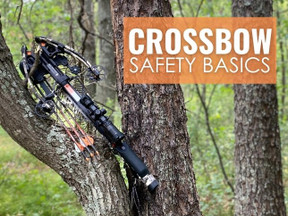Posted by Archery Country on Oct 26th 2018
Crossbow Safety Basics
Shooting a crossbow can be a very fun and also effective way to participate in archery. With crossbows getting faster and more powerful year after year, you need to make sure you take a couple of precautions and understand crossbow safety before firing your new crossbow.
Examine Your Crossbow
The first thing to do is look over your bow extensively, especially your strings, cables, cams, and limbs. If you see any hairline cracks in your limbs, fraying, or cuts in your string/cable, then bring it to your bow shop for them to take a look at it and see if they should be serviced.
Also, most crossbow strings will need to be waxed and rails need to be lubed to help strings last longer. Make sure to do those things before you get ready to cock your crossbow.
Safety While Cocking A Crossbow
With several different crossbows on the market that are cocked in different ways, it’s difficult to go into the specifics on proper cocking; however, there is one basic concept that holds true to all crossbows: The crossbow’s string must be pulled back until it engages the fire control mechanism that holds the string back (or cocked) until the trigger is pulled.
When cocking back the string on the bow, one should use the appropriate cocking aid for the bow. There are generally two kinds of cocking devices, rope cockers, and cranks.
Rope cockers reduce your pull by half using a pulley and also make it easier to pull the string back the same each time. There are different types of rope cocking devices for different bows, so either refer to your owner's manual or get in touch with us and we can recommend the correct one for your crossbow.
Many crossbows either come with cranks or have cranks available for them. The cranks make it easier to draw back your bow than using a rope cocker.
Safely Loading A Crossbow
The first step is to grab the arrow right behind its tip or broadhead in order to load it on the barrel. Make sure your hand doesn’t go past the arrow’s flight path. It is important to make sure that if the bow goes off accidentally, your hands aren’t harmed by the arrow's point or the string.
The second step is to position the arrow so that the odd-colored vane is faced down so that it is in the barrel's channel. Then use your fingers to slowly push the nock towards the string to avoid any injuries. Once the nock is close to the string, firmly push to make sure it connects, avoiding accidental dry fires.
When loading your crossbow, make sure that you use the correct bolt that the manufacturer recommends, if you shoot the wrong nock, this will do damage to your bow. Another thing to inspect is the bolt itself. If the bolt has any cracks in it, it could blow apart at the shot. While loading your bolt make sure your fingers are holding the bolt in a way that if it fired it would not go through your hand. Just like a gun, always treat it like it could go off at any time and never point it towards anybody.
Loading the crossbow simply consists of placing an arrow on the cocked crossbow’s barrel, or flight deck, and making sure its nock contacts the string.
Keep fingers down!
When you are getting ready to pull the trigger, make sure you keep your front hands fingers down out of the way of the string path as it shoots. This is probably the number one injury by people shooting crossbows.
These tips will help you have a safe experience, please also refer to your crossbow’s manual for safety procedures for your individual crossbow.

